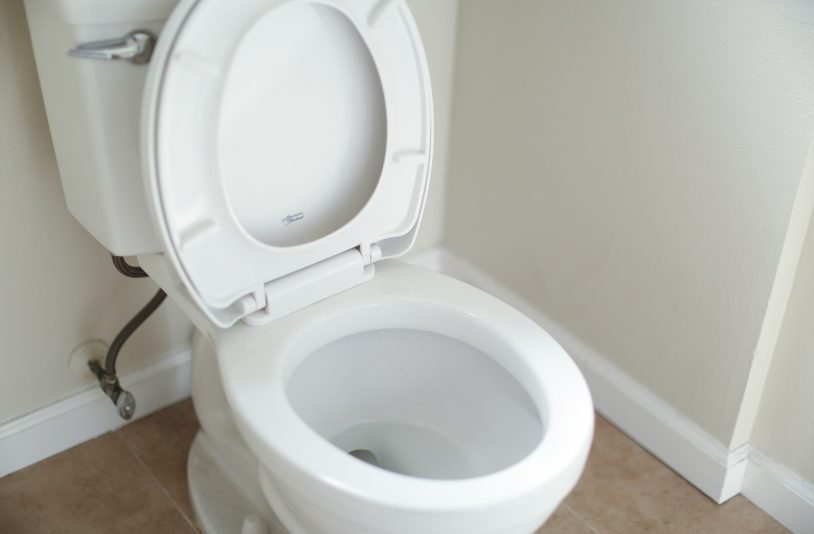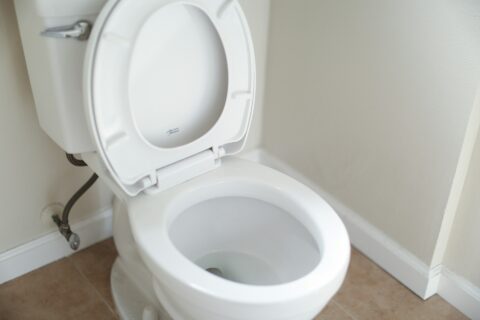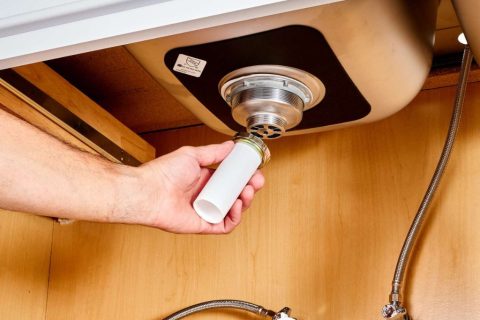
Over time, stains can build up in your toilet bowl, making it look dirty even if it is cleaned. These stubborn marks are usually caused by hard water, minerals, or everyday use, and they don’t always go away with a quick brush swipe.
Knowing how to clean a toilet bowl stain correctly can save you time and effort.
In this guide, we’ll walk you through simple and effective ways to remove tough toilet bowl stains using tools and ingredients you probably already have at home.
Let’s dive in and get your toilet bowl fresh and clean quickly!
Jump to Section [Hide]
Tools and Materials You’ll Need
You’ll need a few key items to get started with cleaning. These tools make the job faster and easier, while keeping your bathroom spotless.
Protective gloves and a toilet brush
Wear protective gloves to keep your hands clean and safe. They shield you from germs, bacteria, and harsh cleaning agents like bleach or hydrogen peroxide.
Use a sturdy toilet brush with firm bristles. It helps scrub away mineral buildup and tough stains without damaging the surface.
White vinegar
White vinegar works great on tough toilet stains. Spray it generously inside the bowl. Let it sit for 30 minutes to break down grime and discoloration. Afterward, scrub with a toilet brush to remove loosened stains.
It’s safe, natural, and free of harsh chemicals. In addition to cleaning, it helps reduce bathroom odors. If needed, use it with baking soda or borax for deeper cleaning power!
Baking soda
Baking soda works wonders for toilet stains. Sprinkle a generous amount into the bowl. Grab your toilet brush and scrub well to loosen grime. Pour 2 cups of vinegar over the baking soda.
It will fizz, which helps lift tough stains.
Let the mixture sit for about 30 minutes. Scrub again to remove any remaining spots, then flush the toilet clean! This method is easy, natural, and effective on most stains.
Hydrogen peroxide
Wear gloves before starting. Pour 1 cup of hydrogen peroxide into the toilet bowl. Let it sit for 30 minutes to whiten and disinfect.
After waiting, scrub with a toilet brush. Sprinkle baking soda if any stains remain, then wash again gently. Flush to rinse the bowl clean.
Borax
Mix 1/4 cup of borax with 1-2 cups of white vinegar. Pour this mixture into the toilet bowl. Let it sit for 20-30 minutes to loosen stains. Scrub the bowl with a toilet brush, focusing on stained areas.
Flush twice to rinse away residue.
Borax is a powerful cleaner that works well on tough stains. It also helps kill germs and deodorize your toilet bowl. Pairing it with vinegar boosts its effectiveness, giving you cleaner results without strong chemical cleaners found in stores like hgtv.com products or discovery+ suggestions.
Pumice stone
A pumice stone works well on tough toilet stains. Wet the stone before using it to avoid scratches. Gently rub the stained area with light pressure. Test a small spot first to ensure it’s safe for your bowl.
Focus on mineral stains like lime or rust buildup. Use steady strokes, and don’t scrape too hard. After cleaning, flush the toilet to rinse away loose residue. This tool helps keep your bathroom hygienic and stain-free!
Toilet cleaner
Choose a noncorrosive toilet cleaner for regular use. It helps remove stains and keeps your bowl fresh. Use once weekly to prevent buildup and bacteria.
Look for tablets that dissolve slowly in the tank. These can save time by cleaning with every flush. Combine them with brushing to tackle tough spots!
Old toothbrush or scrub brush
Use an old toothbrush or scrub brush to remove tough toilet bowl stains. Scrub the area gently to avoid scratches. A toothbrush’s small size helps you reach tight spots, like under the rim.
Pick brushes with stiff bristles for better results. This tool works well with baking soda, vinegar, or other cleaners. It makes cleaning practical and easy, perfect for bathroom cleaning tips!
Safety goggles and mask
Wear safety goggles to shield your eyes from splashes. Cleaning chemicals can irritate or harm your eyes if they come into contact.
Put on a mask to avoid breathing in strong fumes. Certain cleaners, like bleach and vinegar, release vapors that may affect your lungs. Keep yourself protected during household chores like this one!
Step-by-Step Methods to Remove Stains
Tackling toilet stains is easier with the correct method. Follow these steps to bring back a spotless shine!
Method 1: Using Vinegar and Baking Soda
Step 1: Put on gloves before starting.
Step 2: Sprinkle baking soda evenly over the stains in your toilet bowl.
Step 3: Use a toilet brush to scrub gently, focusing on the stained areas.
Step 4: Pour 2 cups of white vinegar into the bowl.
Step 5: Let it sit for 30 minutes while it fizzes and breaks down grime.
Step 6: Scrub again with your brush, then flush away the mess.
Step 7: Repeat if needed for tough stains!
Method 2: Using Hydrogen Peroxide and Borax
Step 1: Wear gloves to protect your hands.
Step 2: Pour 1 cup of hydrogen peroxide into the toilet bowl.
Step 3: Let it sit for 30 minutes.
Step 4: Scrub with a toilet brush to remove stains.
Step 5: Sprinkle baking soda on any stubborn spots. For extra cleaning, mix 1/4 cup borax with 1-2 cups vinegar and pour it in.
Step 6: Wait another 20-30 minutes, scrub again, and flush twice.
This method easily chelates tough stains without harsh chemicals.
Method 3: Using a Pumice Stone
Step 1: Wet the pumice stone before using it.
Step 2: Gently scrape the stains with the wet stone to avoid scratches on the bowl.
Step 3: Focus on tough spots and scrub in small circles.
Step 4: Flush often to assess progress and clear debris. Test a small area first to ensure no damage occurs.
Use this method for stubborn stains that other cleaners can’t remove easily.
Method 4: Using Coca-Cola
Step 1: Pour 16 ounces of Coca-Cola into the toilet bowl.
Step 2: Let it sit for several hours or overnight to break down tough, hard water and mineral stains.
Step 3: Scrub the bowl with a toilet brush to remove any loosened buildup.
Step 4: Flush twice to rinse away residue and reveal a clean surface.
The citric acid in the cola helps dissolve these stains effectively. For safety, wear protective gloves during cleaning.
Natural vs. Chemical Cleaners: What to Consider
Natural cleaners are safer for you and the environment. Vinegar and baking soda work well on stains. Hydrogen peroxide kills germs without strong odors. These options cost less and reduce chemical exposure.
Chemical cleaners, like toilet tablets, clean fast but may harm surfaces if used too much. Some have strong smells that need good ventilation. Choose noncorrosive products to protect your toilet bowl from damage.
Tips to Prevent Future Toilet Bowl Stains
Keep your toilet spotless with simple changes. A little care daily can save a lot of scrubbing later!
Flush regularly
Flush unused toilets daily to prevent stains. This keeps water fresh and stops minerals from building up.
Daily flushing also avoids terrible smells and bacterial growth. If you leave a toilet unused, flush it at least once a day for cleanliness.
Install a water softener
A water softener stops hard water stains by removing calcium and magnesium from the water. These minerals cause brown or yellow rings in the toilet bowl. Softened water also helps keep toilets, sinks, and pipes cleaner.
Install a unit near your main water line. You can choose between salt-based or salt-free systems. Salt-based ones are common for homes with serious, challenging water issues. A professional plumber might be needed for a proper setup.
This one-time step saves time spent scrubbing stubborn stains later!
Use toilet tablets or cleaners
Toilet cleaner tablets are easy and help a lot. They fight stains and keep your bowl fresh. Choose noncorrosive ones to avoid damage to the tank or pipes.
Drop one tablet into the toilet tank after flushing. It will work each time you flush, stopping stains before they form. Cleaners like this can make weekly scrubbing quicker. Use them with regular cleaning for better results!
Keep a consistent cleaning schedule
Clean your toilet bowl at least once a week. Hard water areas may need cleaning more often to prevent stains.
Use noncorrosive toilet cleaner tablets between cleanings to prevent buildup. Flush unused toilets daily, and clean the tank twice a year for better results.
Check for slow leaks
Leaks can cause water to build up and leave stains over time. To check your toilet tank, add a few drops of food coloring. Wait 15 minutes without flushing. If the color shows in the bowl, you leak.
Fix leaks quickly to stop staining and save water. If it’s difficult to find or repair the issue yourself, a plumber may help.
What to Avoid When Cleaning Toilet Stains
Skip tools that scratch surfaces. They’ll damage the bowl. Also, avoid combining cleaning products, as it can create unsafe fumes.
Abrasive brushes
Abrasive brushes can scratch your toilet bowl. Scratches make stains worse by trapping dirt and grime. Avoid using them, even on tough stains.
Choose softer tools like an old toothbrush or scrub brush, and clean them without harming the surface of your toilet bowl.
Mixing chemicals
Mixing chemicals can be hazardous. Never mix bleach with vinegar. This creates toxic gas that harms your lungs and eyes. Always wear safety goggles and a cleaning mask to protect yourself from fumes.
Keep cleaning agents separate unless the label says they are safe to combine. Store products tightly closed and away from children. Read all instructions carefully before use for safety.
Ignoring stains
Stains can get worse if ignored. Hard water, rust, and minerals build up over time. These stubborn spots damage the surface of your toilet bowl. You may need harsher cleaners or tools later to remove them.
Weekly cleaning helps prevent this problem. Flush unused toilets daily to stop stains from forming. Clean the tank twice a year to reduce mineral buildup inside the bowl. Regular care saves effort and keeps your toilet looking clean!
When to Call a Professional
Call a professional if stains do not come off after trying several methods. Tough stains or damage might need expert help.
Elleisha’s Property Services in Wollongong and Newcastle offers trusted cleaning. On weekdays, from 8:30 AM to 4:30 PM, you can reach them at 1300 533 305.
The Bottom Line
Cleaning toilet bowl stains doesn’t have to be hard. You now know how to handle stains like rust, mold, and hard water marks. Simple tools like vinegar, baking soda, or even a pumice stone make the job easy.
Stick with natural methods for safe cleaning or choose chemicals if needed. Regular care prevents future stains and keeps your toilet fresh. Try these steps today for fast results! Keep up a routine for a cleaner bathroom every day.








